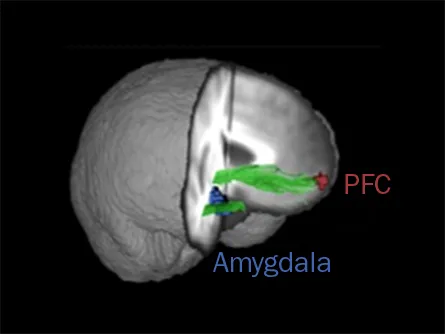Weaker brain links found in psychopaths
Decreased communication between emotional and executive centers may contribute
- More than 2 years ago
Brain differences might help explain psychopaths’ cold, calculated and often antisocial behavior, and perhaps even point out better ways to treat or prevent the disorder, a study of Wisconsin prison inmates suggests.

Compared with a group of 13 non-psychopathic criminals, a group of 14 psychopaths had weaker connections between an area near the front of the brain called the ventromedial prefrontal cortex, or vmPFC, and the amygdala, a pair of almond-shaped structures deep in the brain. Earlier studies have hinted that this particular link is important for emotional regulation and aggression.
Neuroscientist Michael Koenigs of the University of Wisconsin–Madison and colleagues discovered the weaker connection by taking a mobile brain scanner to a medium-security prison. Psychopaths are overrepresented in prison populations thanks to their lack of empathy and tendency toward antisocial behavior.
After interviewing inmates and scrutinizing their disciplinary records to determine whether they were psychopaths, the scientists conducted two kinds of brain scans. The first measured the strength of brain connections called white matter tracts, which are bundles of nerves that serve as information superhighways that shuttle information between different brain regions. It was those scans that revealed the weaker link between the vmPFC and the amygdala in psychopaths, the team reports November 30 in the Journal of Neuroscience.
In the second kind of brain scan, the team assessed which brain regions were coordinating their activity while the prisoners were daydreaming. Normally, the vmPFC and right amygdala work in tandem. But in psychopaths this coordination is lower, the team found.
Finding a breakdown in vmPFC connections was particularly intriguing to Koenigs. Neurologists have long observed that after damage to this area, people can take on personality traits that are reminiscent of psychopathy, including diminished empathy and irresponsible behavior. The results offer direct evidence that the link between the vmPFC and the amygdala is compromised in psychopaths.
“This article does a marvelous job of integrating what we know about brain function,” says experimental psychologist Robert Hare of the University of British Columbia in Vancouver, who was not involved in the study. “What’s striking is that it’s confirming what clinicians have suspected and discussed and talked about. Now we’re getting down to the real nitty-gritty here.”
Hare cautions that identifying what’s different in the brains of psychopaths isn’t the same thing as figuring out the cause of psychopathy. The weakened connections seen in the Wisconsin study could be a by-product of some other environmental or genetic factor commonly found among psychopaths.
“We have a chicken and an egg, in a sense,” he says. “There’s a tendency, certainly among people in the criminal justice system, to take any of these deficits and say, ‘Wow, we have a psychopath who has all these behavioral problems, and now we have this brain anomaly or dysfunction that seems to match, therefore one caused the other.’”







